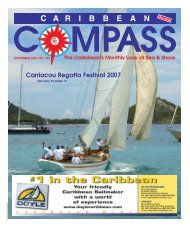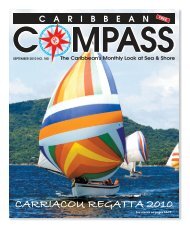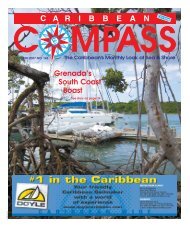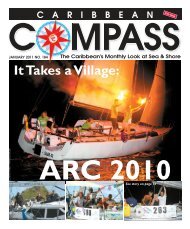You also want an ePaper? Increase the reach of your titles
YUMPU automatically turns print PDFs into web optimized ePapers that Google loves.
COASTAL HIKING<br />
by Jo-Anne Nina Sewlal<br />
ALL ASHORE…<br />
At first glance you might be thinking, “Coastal hiking — what a concept!” But,<br />
whether you are sailing between the islands or just taking a boat around the<br />
coast to fish or down to one of the offshore islands to lime (Trinidad & Tobago<br />
slang for “hanging out”), it is a way of getting close to nature. So why hike if you took<br />
to the waters to get away from the land? This why I came up with the concept of<br />
coastal hiking, as you do not have to venture very far inland since the coast provides<br />
many opportunities to hike, so you get to enjoy the best of both worlds.<br />
Many islands have trails that take you along the coast, and some coastlines are so flat<br />
that you don’t need a trail. One such island that I have visited is Nevis, where the area<br />
along Indian Walk takes you to the ruins of various sugar plantation stone structures<br />
such as windmill bases, a great house, a refinery and a lime kiln. And as you walk along<br />
the coast you see the ocean on one side and Nevis Peak in the distance. On this walk<br />
you are not alone as there are lots of feral sheep, goats and donkeys. Despite the fact<br />
that they are feral, they rarely pose a threat and will often run at the sight of you.<br />
As you move inland you see distinct changes in the vegetation. Along the coast<br />
there is short, gnarly vegetation shaped by the wind action. These plants have tough<br />
succulent leaves that can withstand the sea spray. This gives way to grassland<br />
which is dotted with shrubs, and this leads to thicker vegetation. However, if you do<br />
venture inland from this route, as you get to the grassy area you come across a network<br />
of trails. But you must exercise caution as some of these were made by these<br />
feral animals and if you follow them you might get lost or end up in unusual places<br />
like under bushes, which is where these animals go to get shade from the hot sun.<br />
However, this series of vegetation types is not typical of all islands. Bear in mind<br />
that the conditions and vegetation along the coast of one side of an island are not<br />
necessarily constant all the way round. Varying currents along different parts of the<br />
coast produce rocky beaches or beaches with lots of sand. Then, all sandy beaches<br />
do not have white sand; some, such as Pinney’s Beach in Nevis, are black.<br />
When it comes to vegetation, variation is also seen: coasts with gentle breezes have<br />
larger vegetation including seagrape and sea almond trees, while others with heavy<br />
winds tend to have short, twisted vegetation. An example of this is on Anguilla, where<br />
Windward Point is much drier, so as you move from the shore you meet a small strip<br />
of windswept vegetation and then patches of Turk’s Cap cacti. Some of the islets lying<br />
off the larger islands in the <strong>Caribbean</strong> are so tiny that there is even less variety in vegetation.<br />
Anguilla again presents itself as an example; one of its offshore islands is<br />
Prickly Pear Island, so called because of the abundance of this cactus there.<br />
Of course when you think of hiking, you think of barrelling your way through vegetation,<br />
but with coastal hiking the vegetation is sometimes so dense that you end<br />
up going around it rather than through.<br />
������� �������� ��� ���������� ������� ��������<br />
Coastal hiking is not without its dangers. Most of the<br />
coastal areas in the islands have the manchineel tree.<br />
The sap from this tree is very caustic and is said to strip<br />
the paint off a car. When it rains, the water that drips<br />
from the leaves is a dilute solution of this caustic sap. So<br />
if you were to use it as shelter, your skin would get very<br />
irritated and probably blister. This diluted sap has been<br />
known to cause temporary blindness. This tree can be<br />
identified by its leaves, where a tiny dot (actually a<br />
gland) is present at the junction where the stem started<br />
from the base of the leaf. DO NOT EAT THE SMALL,<br />
GREEN APPLE-LIKE FRUITS OF THIS TREE.<br />
There is not much gear involved in coastal hiking,<br />
beyond light cool clothes, sneakers or boots (cactus<br />
spines can easily penetrate flip-flops), a hat and sunscreen.<br />
But, as with hiking farther inland, it is a good<br />
practice to walk with a few first-aid supplies, such as<br />
bandages, insect repellent to prevent bites (mostly from<br />
mosquitoes and sandflies), and an antihistamine cream<br />
in the event you do get bitten or scratched. Also, we all<br />
think of hiking as a means of getting close to nature and<br />
away from society and technology. But you should walk<br />
with a cell phone or hand-held VHF, so you can contact<br />
help in case you get into difficulty. You may also want<br />
to carry a camera to capture the memories.<br />
Islands have no shortage of coastline and in turn no<br />
shortage of coastal hiking opportunities. But no island<br />
is ever the same and every hiking experience is unique.<br />
Above: St. Kitts’ southeast peninsula. The allure of hiking along the <strong>Caribbean</strong> coastline<br />
speaks for itself<br />
Below: Sun-, wind- and salt-tolerant vegetation, such as the Turk’s Cap cacti in<br />
Anguilla, are tough and prickly, so wear stout shoes. Also drought-tolerant, they<br />
serve to remind hikers to carry plenty of drinking water!<br />
JANUARY 2008 CARIBBEAN COMPASS PAGE 31
















